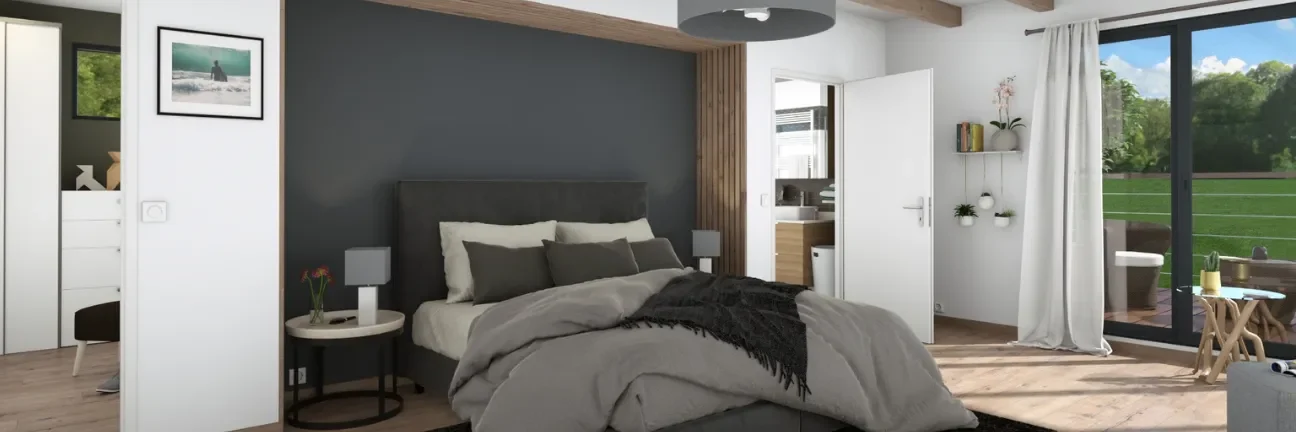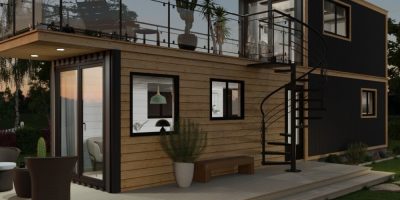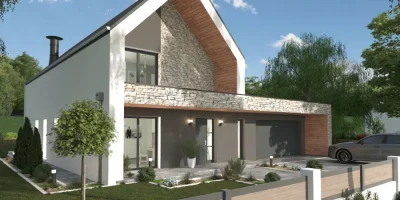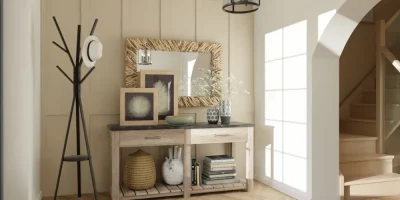The perfect bedroom design can transform your client’s home by adding both value and comfort. In this comprehensive guide, we’ll cover the latest bedroom design ideas so you can cater your bedroom design projects to various tastes and lifestyles.
From eclectic to minimalist and with layouts tailored to different needs, this 5-minute read from the home design pros at Cedreo provides practical tips to streamline your next bedroom project.
- Curious about how to mix styles or maximize small spaces?
- Want to see how to design a master bedroom that promotes better sleep?
Read on to uncover those insights and more so you can wow your clients with your bedroom design ideas. Start with the next section on the most popular bedroom styles.
Bedroom Styles Admired by the Design Community
Mastering popular bedroom styles can make all the difference in creating appealing and functional designs. Here are the top bedroom decorating ideas loved by the interior design community:
Eclectic
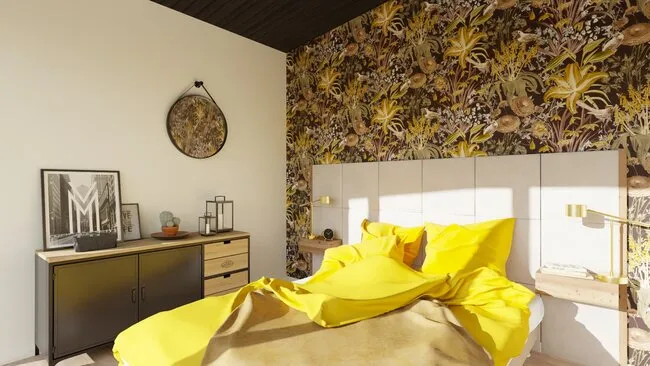
Eclectic bedroom designs combine strikingly diverse elements. They blend various styles, colors and textures to create a unique and personalized space. This bedroom idea often features a mix of vintage and modern pieces, bold paint colors and a combination of textiles. The end result is a bedroom design that feels both curated and spontaneous.
Tips for Implementing In Your Own Bedroom Designs:
- Mix and Match: Use contrasting textures and patterns to add interest. For example, pair a velvet headboard with a rustic wooden bed frame and patterned throw pillows to create a rich, layered look.
- Vintage Meets Modern: Combine vintage furniture with modern accents.
- Balanced Colors: Mix bold paint colors with neutral tones to balance the room.
- Textile Variety: Incorporate diverse textiles such as throw pillows and cozy bedding. Layer different fabrics like a linen duvet cover with knitted throws and silk cushions to add depth and create an inviting space.
- Unique Decor: Choose eclectic artwork and decor pieces to personalize the space.
Scandinavian
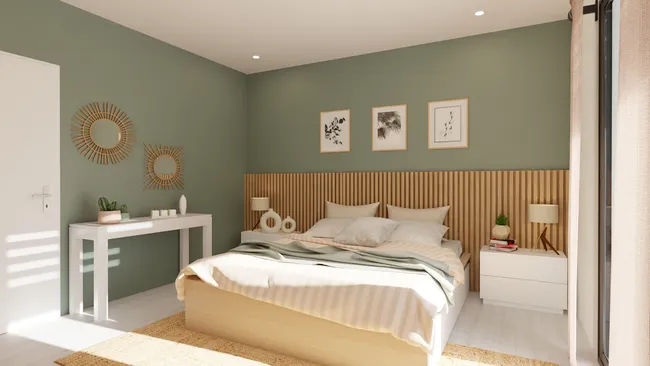
Whether it’s a master bedroom or a small bedroom for guests, Scandinavian bedroom designs emphasize simplicity, functionality and a connection to nature. This interior design style features clean lines, natural materials and a neutral color palette with cool tones. This creates a serene and minimalist atmosphere that promotes relaxation.
Tips for Implementing In Your Bedroom Design:
- Minimalist Furniture: Choose furniture with clean lines and a minimalist design. For example, opt for a sleek, low-profile platform bed frame with simple nightstands. Avoid ornate details to maintain a clean and uncluttered look.
- Natural Materials: Combine natural materials like wood, wool and linen. Use a wooden bed frame, wool area rugs and linen curtains to bring warmth and texture to the room while staying true to the natural aesthetic.
- Neutral Palette: Use a neutral color palette with cool tones for accents. Paint the walls a soft white or light gray and add cool-toned accents like a pale blue throw or green cushions to create a calming environment.
- Functional Decor: Keep decor simple and functional. Choose multi-purpose furniture, such as a bench with storage at the foot of the bed or wall-mounted shelves that provide both display and storage space.
- Cozy Elements: Add cozy bedding and throws to enhance comfort. Layer the bed with a plush duvet, soft cotton sheets and knitted throws to create an inviting and comfortable sleeping area.
Transitional
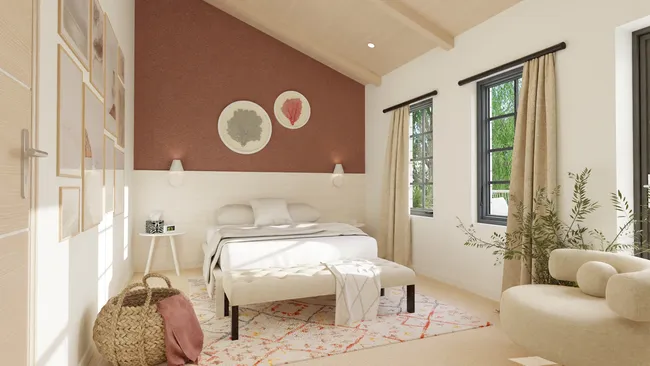
Transitional bedroom designs blend traditional and contemporary elements to create a timeless look. You can achieve this with a balanced mix of classic and modern furniture, neutral color schemes and subtle patterns.
Tips for Implementing In Your Bedroom Design:
- Classic Meets Modern: Combine traditional furniture with modern accents. For instance, use a classic wooden dresser with intricate detailing and pair it with a sleek, contemporary mirror or modern metallic lamps.
- Neutral Colors: Use a neutral color palette to maintain a cohesive look. Paint the walls in shades like beige, taupe or soft gray. Then complement them with neutral-colored furniture and bedding. This creates a soothing backdrop that allows other design elements to stand out.
- Subtle Patterns: Add interest with subtle patterns and textures. Incorporate a patterned area rug with understated designs or use textured wallpaper with a subtle motif. This adds depth to the room without overwhelming the senses.
- Elegant Lighting: Incorporate elegant lighting fixtures to enhance the space. Choose chandeliers or pendant lights with clean lines and refined details. A crystal chandelier adds a touch of sophistication, while contemporary table lamps on bedside tables offer practical elegance.
- Versatile Furniture: Choose versatile furniture that complements both traditional and modern styles. Go with pieces like a tufted headboard that can fit into a classic or contemporary scheme, or a modular sofa that can be adapted to different layouts and design preferences.
Contemporary
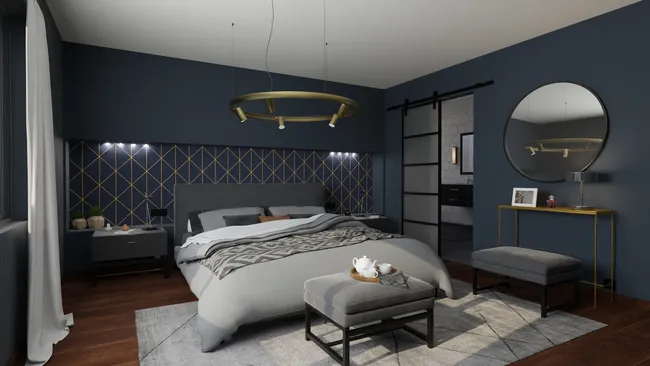
Contemporary bedroom design ideas focus on current trends like sleek lines, bold colors and innovative materials. This style is dynamic and constantly evolving and reflects the latest in design and technology.
Tips for Implementing In Your Designs:
- Modern Furniture: Use sleek, modern furniture with clean lines. For example, choose a platform bed with a low profile and minimalistic design. Then pair it with streamlined nightstands made of metal or lacquered wood to create a sophisticated look.
- Bold Colors: Incorporate bold colors and innovative materials. Create a focal point with a bold accent wall in a deep, rich paint color like navy blue or emerald green. Incorporate materials such as glass, metal or acrylic in furniture and decor for a modern touch.
- Minimal Decor: Keep decor minimalistic yet striking. Decorate with a few key pieces, such as a large abstract painting or a sculptural vase. This creates visual interest without cluttering the space.
- Focal Points: Use statement pieces to create a focal point in the room. Place a dramatic chandelier above the bed or an eye-catching piece of furniture, like an oversized headboard or a designer chair, to draw attention and anchor the room’s design.
- Smart Technology: Integrate smart technology for added convenience. Install smart lighting systems that can be controlled via smartphone or voice command. Smart blinds or curtains that adjust automatically are an excellent choice for a main bedroom..
Minimal vs Maximalist
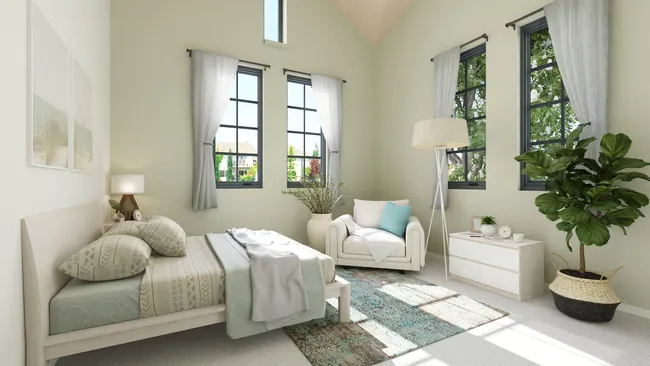
Minimalist bedroom designs emphasize simplicity and functionality with a focus on decluttering and using only essential items. Maximalist designs, on the other hand, celebrate abundance and opulence with rich colors, textures and a wide variety of decorative elements.
Tips for Implementing In Your Designs:
- Minimalist Bedroom Idea: Use a monochromatic color palette and streamlined furniture. Opt for shades of white, gray or beige. Choose sleek, modern pieces with clean lines, such as a low-profile bed with integrated storage.
- Maximalist Bedroom Idea: Incorporate bold patterns, vibrant colors and diverse textures. Mix patterned wallpaper, colorful floor rugs and textured throws. Combine fabrics like velvet, silk and cotton in bedding and upholstery.
- Functional Decor: For minimalism, focus on decor that maximizes space. Choose multi-purpose furniture like a bed with built-in drawers or a wall-mounted desk. Keep decor simple with a few aesthetic and practical pieces.
- Layered Decor: For maximalism, layer textiles and artwork. Create a gallery wall with framed artworks and drape multiple throws over the bed or chairs. Use decorative pillows in a variety of patterns and textures.
- Balanced Bedroom Design: Blend minimal and maximal elements. Start with a neutral, minimalist base and add maximalist accents like a bold patterned rug or vibrant artwork to create bedrooms that feel expansive and personalized.
Bedroom Layouts Ideas for Different Lifestyles
Choosing the right bedroom layout is the next step in creating functional and comfortable bedrooms tailored to your client’s lifestyle. Here are some innovative bedroom layout ideas designed to meet various needs and preferences.
Primary Suite with Sitting Area
A primary suite with a sitting area offers a luxurious master bedroom retreat within the home. This layout needs a spacious bedroom to get started. In addition to the traditional bed and nightstands, this bedroom layout includes a cozy sitting area with a sofa or armchairs, and often a fireplace or large windows for natural light. The sitting area provides a private space within the home for relaxation and leisure.
This Bedroom Layout Is Ideal for:
- Homeowners who seek a relaxing, elegant space to unwind. It’s the perfect main bedroom for clients who enjoy having a dedicated area for reading, lounging or enjoying quiet moments. This layout also suits those who entertain guests and need a stylish, multi-functional bedroom layout.
Multi-Functional Bedroom
A multi-functional bedroom design serves multiple purposes, such as a sleeping area, workspace and relaxation zone. This layout often includes a bed, des, and comfortable seating in order to maximize the room’s functionality. It’s designed to make the most of the available space while maintaining a cohesive and aesthetically pleasing design.
This Layout Is Ideal for:
- Individuals who work from home and don’t have space for a separate office. It’s perfect for small homes or apartments where maximizing space is essential. This bedroom layout is also great for students or young professionals who need a combination of functionality and style in their living space.
Multiple Sleeper Area
A multiple sleeper area is designed to accommodate more than one person. This bedroom idea usually has multiple beds or a combination of a bed and another multi-functional piece of furniture like a futon, sofa bed, day bed or Murphy bed.
This Layout Is Ideal for:
- Families with children sharing a room or homeowners who frequently host guests. This bedroom idea is ideal for creating a flexible and accommodating bedroom space that can easily adapt to the needs of different occupants. This layout also works well in vacation homes or rental properties where your clients need to make the best use of all available space.
So far we’ve covered bedroom styles and layouts — two important pieces in the bedroom design process. As an experienced designer, decorator or builder, it’s easy to visualize the bedroom ideas in your mind. But helping your clients envision them is another story. That’s the genius behind Cedreo!
With Cedreo’s easy-to-use 3D software, you can skip the hassle and show your clients photorealistic renderings of your exact vision for their new bedroom design regardless of the style or layout. With a FREE version you’ve got nothing to lose. Try Cedreo today!
Bedroom Ergonomics to Improve Sleep
Optimizing bedroom ergonomics is essential for enhancing sleep quality and overall comfort. Here are some key bedroom design ideas for creating a sleeping environment that promotes relaxation and well-being.
Layered Lighting
Layered lighting involves using multiple light sources, such as ambient, task and accent lighting, to create a balanced and flexible lighting scheme. This approach ensures the bedroom is well-lit for various activities while also allowing for a calming atmosphere conducive to sleep. Properly layered lighting can also reduce eye strain, improve mood and help regulate the body’s circadian rhythm.
Layered Lighting Considerations:
- Ambient Lighting: Use ceiling lights or wall-mounted fixtures to provide overall illumination.
- Task Lighting: Include bedside lamps or reading lights for focused activities.
- Accent Lighting: Use spotlights or LED strips to highlight artwork or architectural features.
- Dimmers: Install dimmer switches to adjust light levels and create a relaxing environment.
Height of Furniture
The height of bedroom furniture can impact both aesthetics and functionality. Properly scaled furniture ensures comfort and ease of use, which is important for a restful environment. Beds, nightstands and other furniture pieces should be at heights that promote ergonomic comfort and accessibility. This reduces strain during common activities and improves the bedroom’s overall usability.
Furniture Height Design Considerations:
- Bed Height: Ensure the bed is at a comfortable height for getting in and out with ease.
- Bedside Tables: Choose tables that are level with the mattress for easy access.
- Dressers and Drawers: Opt for furniture pieces that are easy to reach and use without bending too much.
- Seating: Include chairs or benches at a comfortable height for sitting and dressing.
Comfortable Headboard
A comfortable headboard provides support and enhances the aesthetic appeal of the bedroom. It can also serve as a focal point of the bedroom design. Upholstered headboards are particularly beneficial as they offer a soft surface for leaning against while reading or watching TV.
Headboard Design Ideas:
- Upholstered Headboards: Use plush fabrics for a soft, cozy feel.
- Wooden Headboards: Choose natural materials for a rustic, warm look.
- Adjustable Headboards: Opt for adjustable designs to cater to different sitting and reclining positions.
- Integrated Storage and Lighting: Consider headboards with built-in shelves or small reading lamps for added functionality.
Clever Storage
Clever storage solutions help keep the bedroom organized and clutter-free. This is especially important for a small bedroom. Efficient storage options also ensure that essential, everyday items are easily accessible. This organization can significantly reduce stress and promote a sense of calm, which makes it easier to unwind and fall asleep.
Bedroom Storage Design Tips
- Under-Bed Storage: Use the space under the bed with drawers or storage boxes.
- Built-In Wardrobes: Maximize vertical space with built-in closets and shelves.
- Multi-Functional Furniture: Choose beds and benches with hidden storage compartments.
- Organizational Accessories: Use drawer dividers, baskets and trays to keep items organized and accessible.
A guide on bedroom design ideas isn’t complete without a talk about the budget. Check out the next section to get an idea of how much the average bedroom remodel could cost.
How Much Does a Bedroom Remodel Cost on Average?
The cost of a bedroom remodel can vary widely depending on several factors, including the size of the room, the extent of the renovations, the quality of materials used and labor costs. On average, homeowners can expect to spend anywhere from $2,000 to $15,000 on a bedroom remodel.
Here are the biggest factors that influence the cost:
- Complexity of the Bedroom Design: More intricate or complicated bedroom designs require more time and skilled labor throughout the entire project.
- Choice of Materials: High-quality or custom materials can significantly increase costs.
- Furniture and Fixtures: Replacing old furniture with new, high-end pieces adds to the budget.
- Structural Changes: Modifying walls, ceilings or floors can add substantial costs.
- Professional Services: Hiring interior designers, architects and contractors can increase overall expenses.
- Smart Technology: Integrating smart home systems and advanced lighting solutions can drive up costs.
- Geographic Location: Labor and material costs can vary significantly by region.
Average Bedroom Remodel Cost
Budget Bedroom Remodel ($2,000 – $5,000):
A budget remodel typically includes basic updates like fresh paint colors, new bedding and replacing outdated furniture. This might also involve minor cosmetic changes such as updating light fixtures or adding new window treatments.
Mid-Range Bedroom Remodel ($5,000 – $15,000):
A mid-range bedroom remodel includes more substantial changes such as new flooring, upgraded furniture and even custom-built storage solutions. It might also involve moderate structural changes like knocking down walls to create an open layout or adding built-in shelves.
High-End Bedroom Remodel (Over $15,000):
A high-end remodel can exceed $15,000 and includes luxury materials and custom designs. This level of remodeling might involve extensive structural changes, high-quality furniture, a canopy bed, bespoke cabinetry, advanced lighting systems and smart home integration. High-end bedroom remodels often result in a more personalized and luxurious space that meets demanding clients’ needs and preferences.
Bedroom Design Software Features You Need
The right bedroom design software can streamline your workflow, enhance project presentations and help you land more clients.
Cedreo helps you do all of that and more! Cedreo is an all-in-one 3D home design software that more building and design professionals are switching to.
Here’s how Cedreo can benefit your business:
- Efficient Design Process: Cedreo’s user-friendly interface and intelligent toolset lets you create a full set of 2D and 3D bedroom drawings in a matter of minutes.
- Enhanced Visualization: Even with ZERO previous 3D experience, you can generate realistic 3D visualizations to help clients understand and approve designs faster.
- Customization: Tailor every aspect of your bedroom designs with an extensive design library of furniture, fixtures and materials.
- Collaboration Capabilities: Cloud software lets you share projects and gather feedback from your team in real-time.
- Cost Estimating Made Simple: Cedreo integrates with CostCertified so you can generate accurate estimates faster.
Sign up for Cedreo today to see what it can do for your business!
